It was more than two weeks before Mt. Fuji stopped erupting.
For 16 days, volcanic rock rained down on the communities at the base of the mountain, blanketing cities over 60 miles away in dense ash.
Buildings collapsed. Currents of superheated debris tumbled through the countryside, destroying everything they touched.
It was 1707 when Mt. Fuji last erupted. Nearly 30 billion cubic feet of ash spewed into the air, choking residents and causing famine in the aftermath as farmlands were destroyed.
Today, the volcano sits still against the Japanese skyline, a symbol of the nation’s beauty, strength and endurance. But researchers warn the placid, snow-capped mountain still holds its fury deep within.
Japan this week released a report detailing the limited actions that could be taken were Mt. Fuji to erupt tomorrow.
A full-scale eruption could generate 17 billion cubic feet of ash to be carried up to 75 miles east. For forty miles, residents unable to flee could witness their houses collapse around them under the weight of the dense output.
Those further away might survive by stocking up with weeks of food and bunkering down. But despite all the advances in monitoring and logistics, Tokyo could not realistically be evacuated all at once.
Instead, the city would grind to a halt with power and water supplies vulnerable to being knocked offline by a mix of ash and moisture. Electronic devices and public transport could be corrupted by debris, crippling the city’s stock exchange with reverberations felt around the world.
In the worst case, researchers assess, 800,000 people could be trapped in the path of pyroclastic flows, burning at more than 1,500F (800C) and coursing towards civilisation at speeds of nearly 200 metres per second.

Mt Fuji as seen from behind the Tokyo skyline, undated
Your browser does not support iframes.
Mt. Fuji is an active volcano sat some 80 miles from the capital, on the island on Honshu.
Against the busy Japanese skyline, a triumph of modern business and architecture, the snow-capped mountain grounds the city with its still, unyielding presence.
But hidden within is a sleeping threat. Mt. Fuji is believed to have erupted at least 16 times since 781 A.D. That works out as one eruption every 77 years or so.
It has now been 317 years. And while meteorologists say there is no sign of imminent activity, a government-appointed panel has again been drawn together to come up with responses to different scenarios should an eruption occur.
The most pressing concern is for the communities at the base of the mountain, directly in the path of pyroclastic flows – currents of gas and volcanic debris full of tiny, sharp particles travelling at nearly 200 metres per second.
These are formed when the volcano erupts, sending lava, ash and gases into the air. They lose momentum and fall back to the earth with gravity, becoming superheated currents at between 200C and 700C (390-1300F).
Until they cool and slow, pyroclastic currents destroy everything in their path. The scorching temperature of debris creates brush fires while rock fragments, potentially the size of boulders, hurtle down the mountain at motorway speeds.
The new study estimates that an eruption could pump 490 million cubic metres (17bn cubic ft) of ash into the atmosphere – tenfold the debris produced by the 2011 earthquake and tsunami, the effects of which are still felt.
On the margins of the explosion, the flows would be hot enough to cause instant death to people and animals. Vegetation on local farms would be smothered by ash, killing plants and raising the risk of famine.
Lava, absent from the 1707 Hoei eruption, would today likely destroy the roads that serve as emergency evacuation routes, hampering evacuations out and rescue missions in.
A 2021 report indicated that a major eruption could release enough lava to sever the main road and rail links around the mountain, disconnecting Tokyo from western Japan by land.
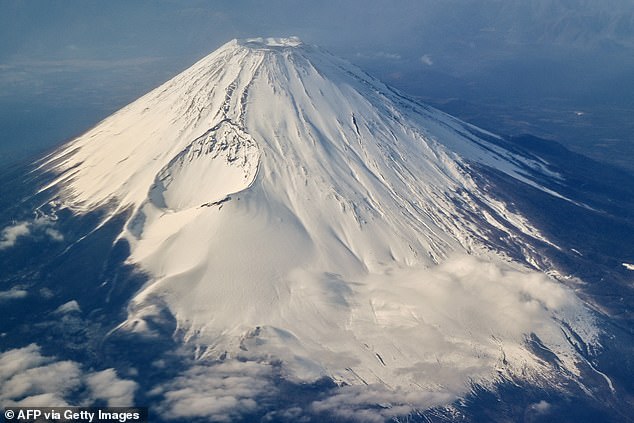
The Hoei Crater is still visible on Mt. Fuji, showing where it erupted in 1707
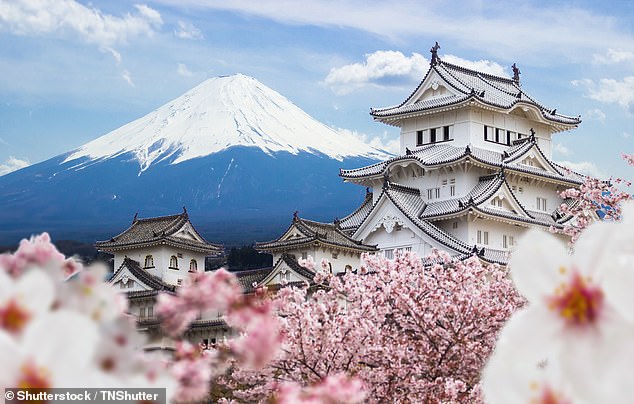
Wooden buildings in the way of heavy ash fall could collapse in the event of an eruption
The last time Mt. Fuji erupted there was no official record taken of how many people were killed. Experts say it is difficult to estimate how much lava and ash could be released today, making casualty estimates as speculative.
A 2021 review estimated that as many as 12 cities and towns could be caught up in lava flows. Pyroclastic flows could travel further, although this also would depend on wind direction and speed, and the size of the eruption.
Heavy ash fall in the affected regions would collapse local communities. In their latest warning, the panel said that ash 30cm deep, when compounded with rain water, would be heavy enough to collapse wooden structures for miles.
Homes as far away as Sagamihara, a city of 723,000 some 40 miles from the summit, could break apart under the weight.
The panel categorised the worst-affected areas under ‘Stage Four’, carrying risk to life.
Those with a categorisation of ‘Stage Three’ would receive between three to 30 centimetres of ash, likely causing blackouts, with essential services like power cut and unable to be restored quickly.
Just three centimetres of ash, potentially stretching out more than 100 miles and affecting most of central Tokyo, could bring entire cities to a halt.
The panel warned that those on dialysis on requiring nursing care should be evacuated in these regions, with electronic devices susceptible to corruption.
Water infrastructure and power plants would also be vulnerable to contamination and knocked offline.
As a result, residents in Stage 3 areas would have to be promptly evacuated. Those with recoverable infrastructure would be classified under ‘Stage 2’, and would not have to leave.
Takeshi Sagiya, a professor at Nagoya University’s Research Centre for Seismology, Volcanology and Disaster Mitigation, told This Week in Asia that the ash would create untold problems for miles.
‘This sort of ash is composed of tiny fragments of melted rock, effectively making it into a very fine glass powder,’ he said.
‘That powder will destroy any electronic equipment that it gets into. It will badly scratch any surface if someone tries to wipe it off, it could collapse homes, and it will immediately block roads and halt trains.’
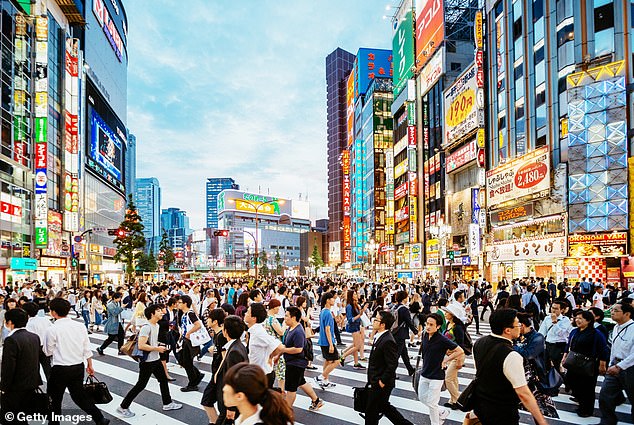
Tokyo and the surrounding areas could grind to a halt in the event of an eruption
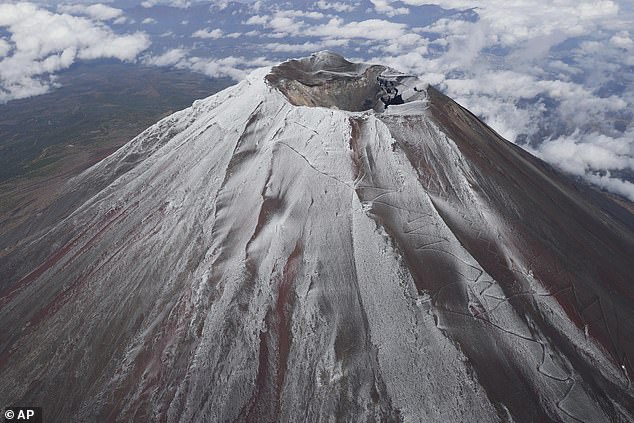
A large eruption could envelop communities in pyroclastic flows, travelling at nearly 200m/s
Aircraft in flight around the eruption would lose engine power if the turbines sucked in the ash, he said.
Just ten centimetres of ash on the ground would be enough to stop cars and motorcycles from being able to drive on the roads. In 1707, the smog was so thick that residents had to light candles to see during the day.
But even a few millimetres on railway tracks would stop trains running altogether, collapsing public transport in the wider Tokyo area.
As such, areas with ashfall under three centimetres would still be classified as ‘Stage 1’, at risk of transport suspensions.
Disruption to the Tokyo Stock Exchange, as well as Japanese banks, finance and venture capital would create major volatility in global markets, and ripple through international trade and stock prices.
In 2020, a panel warned that any major eruption would rain so much ash on the capital Tokyo that its transportation network of trains and highways would be paralysed in just three hours.
Several centimeters of ash would clog the filters at power plants. Visibility would diminish to zero.
An eruption on the scale of Mount Fuji’s last eruption could go on for two weeks, the panel said.
One Tokyo metropolitan government official reportedly said it would take decades to remove all the ash from an eruption if it had to be contained locally.
In the meantime, residents would have to manage with less.
The panel recognised that in the event, local authorities and businesses would have to focus mainly on repairing key infrastructure.
Locals should now be stocking up enough food, water and other supplies to sustain them for two weeks, anticipating supply chain disruption, they said.
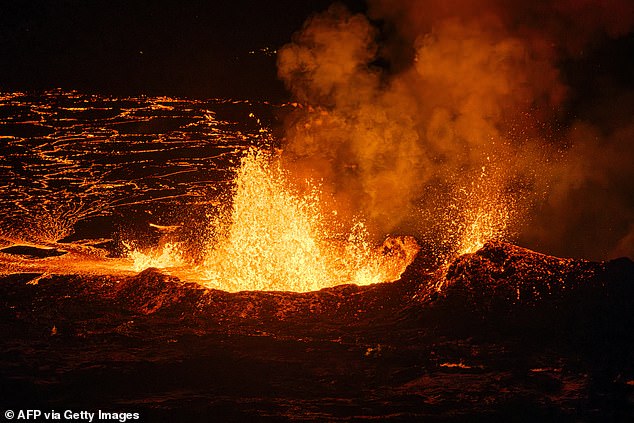
Molten lava spews from a fissure during a volcanic eruption began in Iceland, south of the capital Reykjavik, on December 19, 2023
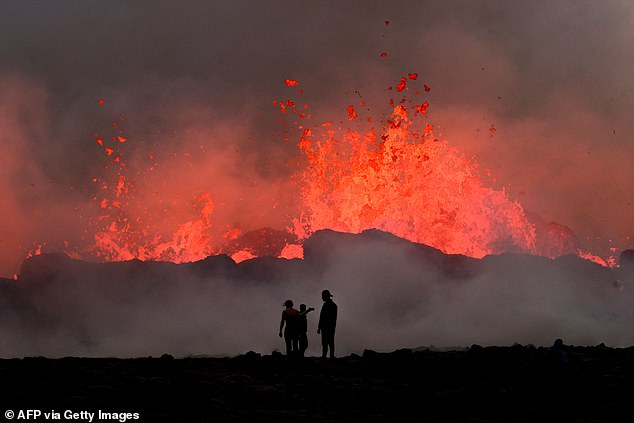
People watch flowing lava during an volcanic eruption near Litli Hrutur, south-west of Reykjavik in Iceland on July 10, 2023
While it lies ‘dormant’, sleeping on the periphery of civilisation, Mt. Fuji remains an active volcano with immense power contained within.
As in 1707, an earthquake off the coast of the country – lying on over 2,000 active faultlines – could be enough to unlock that power, turning the region into a barren hellscape within a matter of hours.
An eruption at the scale of the Hoei eruption could continue for two weeks, researchers warn. Such an explosion would cause untold destruction around Tokyo and force the displacement of hundreds of thousands of people.
Homes would turn to dust under the weight of dense ash as those caught up in the currents of pyroclastic flows were killed instantly by superheated debris.
For now, Mt. Fuji remains still – a symbol of Japan’s strength and beauty, attracting millions each year drawn in by its natural presence of calm.

AloJapan.com